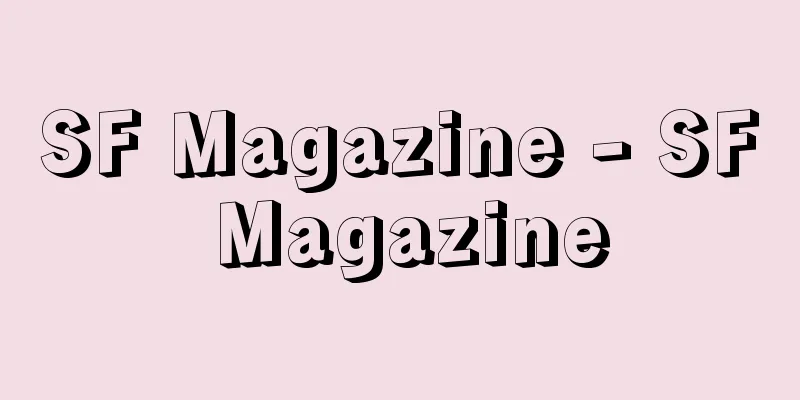Acrobatics - Acrobatics

|
A form of entertainment that amazes the audience with highly skilled techniques, performed as street performances or spectacles. As exemplified by acrobat, whose name comes from the Greek word for "walking on tiptoes," acrobatic performances have been performed in the West for a very long time, but this article will focus on Japanese acrobatics, so for information on foreign acrobatics, please refer to the "street performance" article. Japanese acrobatics originated from the religious incantations of the mountain ascetics, such as fire walking, sword walking, and hot water standing. In addition, it can be said that its origins lie in the various arts of Sangaku that were introduced from the continent during the Nara period, such as issoku, takaashi, ryugo, tops, sorcerers, dwarves, puppets, gijo, enkan, shinadama, and tekiken. After the abolition of the Sangakudo (782), these were passed on from Sangaku priests to Dengaku priests and puppeteers, and then to Sarugaku and the medieval Hokashi. In the Edo period, they became popular as street performances and spectacles, giving rise to many different types of art, and came to dominate the so-called miscellaneous arts of the early modern period. Acrobatics can be broadly categorized into (1) those that use the human body (mainly the hands and feet) to display skills that are the result of training, (2) those that use skills in handling tools or objects, and (3) those that use animals. Acrobatics that are performed through repeated physical training are collectively called "acrobatics." Acrobatics originated from tightrope walking, which arose from the Sangaku art of spider dancing, and later formed a genre that could be called "crossing things," such as one-rope, one-bamboo, and two-bamboo. Other types of tricks include cage escape, lotus jump, blade walking, human-horse, swing, and foot tricks. Next, let us describe some of the acrobatics that use instruments. [Oda Koji] Curved topThe first time that spinning top acrobatics, a type of sangaku acrobatics, was performed as a spectacle show was in 1700 (Genroku 13) when Hatsutaro came to Osaka from Kyushu with his Hakata Curved Top Show. His disciples, including Kanenosuke, went to Edo and made a name for themselves with danshoku and curved tops. It was perfected by Hakata Eizo around the time of the Meiwa and Tenmei eras (1764-1789), and was marked by an era by Takezawa Toji during the Koka era (1844-1848), reaching its height at the end of the Edo period. For generations, medicine seller Matsui Gensui made a living through spinning tops, but in 1866 (Keio 2), the 13th generation traveled to America and introduced curved tops to the West. [Oda Koji] Curved poundingThe curved pounding of millet mochi (rice cakes) began during the Kansei era (1789-1801). A pounder and a kneader would demonstrate their skills by throwing a mallet into the air, or tearing or rolling the mochi into balls and throwing them. The performance was sold with comical speeches and ostentatious movements, and by the Bunsei and Tenpo eras (1818-1844), it had become a spectacle in Osaka, Nagoya, and other areas. [Oda Koji] Song playingThis refers to candy craftsmanship, a musical performance showcasing the skill of crafting starch syrup into various shapes. It became a showpiece during the Kansei era (1789-1801). [Oda Koji] BallIt was introduced from China as one of the Sangaku acrobatics, and is a performance that involves kicking a beautiful spooled ball. Around the Kan'ei and Shoho eras (1624-1648), there is a record in the Bokuyo Kyokashu of a performance by a man named Ukon Toyoshi, but he was sued by the Asukai family, the original family of kemari. During the Tenpo era (1830-1844), Kikugawa Kunimaru gave it the name Magutemari, and performed 19 different pieces, including Rangui-Watari, Nakazuri, and Calligraphy, which were well received, but he was also arrested. Other forms of this genre include horseback riding, sword drawing, and plate spinning. There are many acrobatics using animals. Around the Kansei era, falconry became a show, and there were sea lion acrobatics, tightrope walking by giant bats, and mynah bird impersonations. The mountain sparrow acrobatics that can still be seen today date back to the Bunka and Bunsei eras (1804-1830), and included tricks such as coin collection, the Nasuno Yoichi fan target, and a pilgrimage to Miyajima, but tricks involving drawing fortunes can still be seen occasionally today. Around the Jōkyō era (1684-1688), there was a man named Mizuemon in front of Yushima Tenjin Shrine in Edo, who was said to be a master at training animals to perform these tricks. In Edo, acrobats and acrobats were considered to be people of low status who were placed under the command of Gomunenidayu and Eta-gashira Danzaemon, but it can be said that through their extensive training they created a tradition of highly refined art that is seen in modern circuses. [Oda Koji] "Asakura Musei's 'Study of Spectacles' (1928, Shunyodo)" ▽ "Ono Takeo (ed.) 'Illustrated Manners and Customs of the Edo Era 8: Illustrated Manners and Customs of Spectacles' (1977, Tenbosha)" [References] | | | | | | | | | |"Wakan Sansai Zue" Volume 16 "Entertainment" Edited by Terashima Ryoan Post-published in 1715 (6th year of Shōtoku) Owned by the National Diet Library Escape from the cage "Jinrin Kunming Zui" Vol. 7, published in 1690 (Genroku 3), owned by the National Diet Library Plate spinning Gensui spins a top on the edge of his sword. "Shokunin Tsukushi Ekotoba" second scroll (detail) The original is by Kuwagata Keisai (Masami Kitao) and the inscription by Kyokaen (Shuzanjin) is owned by the National Diet Library . Gensui Matsui's spinning top A colored woodblock print of an acrobatics performance from Chu-Indonesia in 1864 (Genji 1) ( owned by the National Diet Library ) Yoshitoshi Tsukioka's "Yokohama Foreigner's Horse Racing" Source: Shogakukan Encyclopedia Nipponica About Encyclopedia Nipponica Information | Legend |
|
大道芸あるいは見せ物興行として演じられる、おもに練達した高い技術をもって人の目を驚かせる芸能。「つまさきで歩く」というギリシア語に語源をもつアクロバットacrobatに代表されるように、西欧でも曲芸の類は非常に古くから行われているが、本項では日本の曲芸に限定して叙述するので、外国のそれについては「大道芸」などの項を参照されたい。 日本の曲芸は、宗教的な呪術(じゅじゅつ)としての山伏の火渡り、太刀(たち)渡り、湯立(ゆだて)といった技術から発生した系統に加え、奈良時代に大陸から伝来した散楽(さんがく)系の諸芸、一足(いっそく)、高足(たかあし)、輪鼓(りゅうご)、独楽(こま)、呪師(じゅし)、侏儒(しゅじゅ)、傀儡(かいらい)、戯縄(ぎじょう)、縁竿(えんかん)、品玉(しなだま)、擲剣(てきけん)などといった芸能のすべてがその源流となったといってよいであろう。これらが散楽戸の廃止(782)以来、散楽法師から田楽(でんがく)法師、傀儡師に伝えられ、猿楽(さるがく)、中世の放下師(ほうかし)の手を経て、江戸時代には大道芸、見せ物芸として人気を集め、多くの芸種を生むに至り、いわゆる近世雑芸(ざつげい)群の主流を占めた。 曲芸を大きく分けると、(1)人間の肉体(おもに手足)を用いてその修練の成果たる技術をみせるもの、(2)道具や品物を扱う技術をもって芸をなすもの、(3)動物を使うもの、に分類できる。肉体訓練を重ねて行われる曲芸を総称して「軽業」ともいう。軽業は蜘舞(くもまい)という散楽芸からおこった綱渡りが源流で、のちに一本綱、一本竹、二本竹など「渡り物」ともいえる一ジャンルを形成した。ほかに、籠(かご)抜け、蓮飛(れんとび)、刃渡り、人馬(ひとうま)、ぶらんこ、足芸などといった芸が数えられる。 次に器物を用いる曲芸のいくつかについてその内容を記してみよう。 [織田紘二] 曲独楽散楽雑伎(ざつぎ)中の一種であった独楽(こま)の曲芸が見世物興行として行われるのは、1700年(元禄13)九州から大坂に上った初太郎の博多曲独楽(はかたきょくごま)であった。彼の弟子の金之助らは江戸に出て男色と曲独楽で名を売った。明和(めいわ)~天明(てんめい)(1764~1789)のころに博多永蔵によって大成され、弘化(こうか)(1844~1848)の竹沢藤治によって一時代を画し、江戸末期を全盛期とする。売薬売りの松井源水は代々が独楽の芸をもって業を営んだが、1866年(慶応2)には13代目が渡米し、西洋にも曲独楽を紹介した。 [織田紘二] 曲搗き粟餅(あわもち)の曲搗(きょくづ)きは寛政(かんせい)年間(1789~1801)に始まった。搗き手と捏(こ)ね手の2人が杵(きね)を空中に放り投げたり、餅をちぎったり丸めたりして投げる技をみせ、滑稽(こっけい)な口上や振りの大仰(おおぎょう)さで売ったものであり、文政(ぶんせい)・天保(てんぽう)(1818~1844)ごろに大坂、名古屋などで見世物になっている。 [織田紘二] 曲吹き飴細工(あめざいく)のことで、水飴をいろいろな形につくりあげる妙技を曲にのせて見せるもの。寛政(かんせい)年間(1789~1801)には見せ物になっている。 [織田紘二] 曲鞠散楽雑伎の一つとして中国から伝わったもので、美しい糸巻の鞠(まり)を蹴(け)って行う芸。寛永(かんえい)・正保(しょうほう)(1624~1648)ごろ、外良右近(うこん)という者が興行した記録が『卜養(ぼくよう)狂歌集』にあるが、蹴鞠(けまり)の本家飛鳥井(あすかい)家から訴えられている。天保(1830~1844)の菊川国丸が曲手鞠と名をつけて、乱杭(らんぐい)渡り、中吊(づ)り、文字書きなど19通りの演目を演じて高い評判をとったが、やはり召し捕らえられている。 この種にはほかに、曲馬、居合抜き、皿回しなどがある。 動物を用いての曲芸も多い。寛政ごろには鷹遣(たかつか)いが見せ物化しているし、海驢(あしか)の曲芸や大蝙蝠(こうもり)の綱渡り、九官鳥の物真似(ものまね)などがあった。現在でも一部でみられる山雀(やまがら)の曲芸は文化(ぶんか)・文政(1804~1830)ごろからのもので、賽銭(さいせん)拾い、那須与市(なすのよいち)扇の的(まと)、宮島詣(もう)でなどといった芸があったが、おみくじを引かせる芸は今日でもときどき目にすることがある。貞享(じょうきょう)(1684~1688)のころには江戸・湯島天神前に水右衛門なる者がおり、これら動物に芸を仕込む名人であったという。 曲芸軽業師は、江戸では乞胸仁太夫(ごうむねにだゆう)、穢多頭(えたがしら)弾左衛門の配下に置かれていた身分の低い者たちとされていたが、それだけに修練を重ね、近代のサーカスにみるような高度に完成された芸の伝統をつくりあげたといえよう。 [織田紘二] 『朝倉無声著『見世物研究』(1928・春陽堂)』▽『小野武雄編著『江戸風俗図誌8 見世物風俗図誌』(1977・展望社)』 [参照項目] | | | | | | | | | |『和漢三才図会』 16巻 「芸能」 寺島良安編 1715年(正徳6)跋刊国立国会図書館所蔵"> 籠抜け 『人倫訓蒙図彙』 7巻 1690年(元禄3)刊国立国会図書館所蔵"> 皿回し 刀の刃先の上でこまを回す源水。『職人尽絵詞』 第2軸(部分) 原図は、鍬形蕙斎(北尾政美)画、杏花園(蜀山人)詞書国立国会図書館所蔵"> 松井源水の曲独楽 1864年(元治1)の中天竺舶来軽業興行の錦絵国立国会図書館所蔵"> 月岡芳年『横浜異人曲馬』 出典 小学館 日本大百科全書(ニッポニカ)日本大百科全書(ニッポニカ)について 情報 | 凡例 |
Recommend
Ladder fishing - Cat spelling
A method of sea fishing done on a ladder set up in...
Meisterstück (English spelling)
…In the Middle Ages, like other guilds, the guild...
a posteriori language
…Furthermore, Johann Martin Schleyer (1831-1912) ...
Mancunium
…Population: 433,000 (1995). In Roman times it wa...
One year old ice
Please see the "One Winter Ice" page. S...
Nyköping (English spelling)
A port city on the Baltic Sea in southeastern Swed...
Asilidae
...A general term for insects belonging to the Di...
Mordellistena
…The thoracic legs are small and the claws are de...
Sanitary pests - burrowing worms
Insects and mites that are harmful to humans and l...
Leeaceae
…Although it is a woody plant, it is rarely used ...
Religious bandits - Kyohi
…Both Hui and Dang mean “friends,” and originally...
hop hornbeam
...A deciduous tall tree of the birch family that...
Okumusashi
A colloquial name for the area in southwestern Sa...
Large sword - Oodachi
〘Noun〙 (formerly called "Ootachi")① A la...
Title - Kengen (English spelling) title; Rechtstitel
A cause that serves as the basis for a legal or fa...









